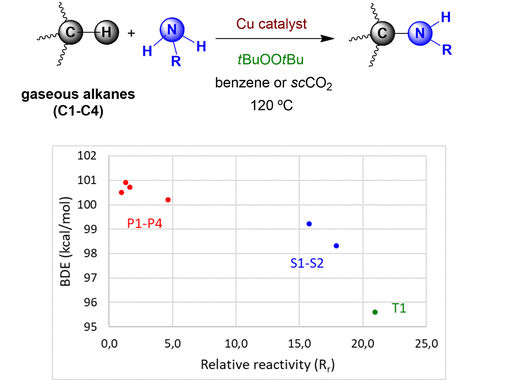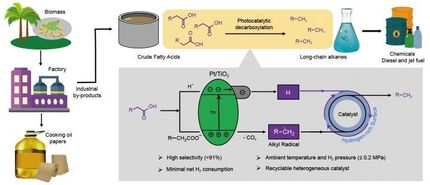At Last: Separated and Freshly Bound
Amidation of light alkanes
The carbon–hydrogen bonds in alkanes—particularly those at the ends of the molecules, where each carbon has three hydrogen atoms bound to it—are very hard to “crack” if you want to replace the hydrogen atoms with other atoms. Methane (CH4) and ethane (CH3CH3) are made up, exclusively, of such tightly bound hydrogen atoms. In the journal Angewandte Chemie, a team of researchers has now described how they break these bonds while forming new carbon–nitrogen bonds (amidation).

© Wiley-VCH
If it were possible to easily break the C–H bonds in hydrocarbons, it would be possible to synthesize complex organic molecules, such as pharmaceuticals, much more conveniently and directly from petroleum. This strategy could also provide more pathways for recycling plastic waste. The formation of carbon–nitrogen bonds is of particular interest because these play an important role in natural products. For example, amide bonds link individual amino acids into proteins.
Although there has been some success in the functionalization of heavy hydrocarbons, even at the end positions, the particularly strong C–H bonds of light alkanes, especially methane, can hardly be split at all. The use of these primary components of natural gas as synthetic building blocks is especially desirable, as it would allow for the use of this often wasted side-product of oil extraction.
A team led by Ana Caballero and Pedro J. Pérez (Universidad de Huelva, Spain), as well as John F. Hartwig (University of California, Berkeley, USA) has now successfully coupled amides (nitrogen-containing organic compounds) to light alkanes with loss of a hydrogen atom. The products of these dehydrogenative amidations are known as N-alkyl amides.
The starting point for this approach was the amidation of C–H bonds in heavy alkanes with a copper-based catalyst and di-tert-butyl peroxide as an oxidizing agent, as developed several years ago by the Hartwig group. Variation of the catalyst led to success. If the copper has phenanthroline-type ligands (an aromatic, nitrogen-containing system of three six-membered rings), it is possible to produce high yields in the reaction of ethane with benzamide—as well as a number of other amides—using benzene as a solvent. The reaction also worked when supercritical carbon dioxide—a more environmentally friendly option—was used as a solvent. The reaction with ethane is an unusual C–N bond formation with a non-activated primary C–H bond.
Propane, n-butane, and iso-butane gave similar results. In the light alkanes, reactivity correlates significantly more strongly with the dissociation energy of the C–H bonds than in higher alkanes.
And methane? Even the toughest candidate—amidation of methane has never previously been observed—could be coupled to the amide. Isotopic experiments were used to prove that methane reacts to form N-methylbenzamide.
Original publication
Other news from the department science

Get the chemical industry in your inbox
By submitting this form you agree that LUMITOS AG will send you the newsletter(s) selected above by email. Your data will not be passed on to third parties. Your data will be stored and processed in accordance with our data protection regulations. LUMITOS may contact you by email for the purpose of advertising or market and opinion surveys. You can revoke your consent at any time without giving reasons to LUMITOS AG, Ernst-Augustin-Str. 2, 12489 Berlin, Germany or by e-mail at revoke@lumitos.com with effect for the future. In addition, each email contains a link to unsubscribe from the corresponding newsletter.




























































